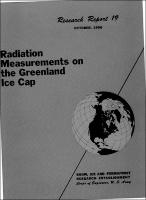Please use this identifier to cite or link to this item:
https://hdl.handle.net/11681/2745Full metadata record
| DC Field | Value | Language |
|---|---|---|
| dc.contributor.author | Diamond, Marvin | - |
| dc.contributor.author | Gerdel, Robert W. | - |
| dc.date.accessioned | 2016-03-14T19:23:27Z | - |
| dc.date.available | 2016-03-14T19:23:27Z | - |
| dc.date.issued | 1956-10 | - |
| dc.identifier.uri | http://hdl.handle.net/11681/2745 | - |
| dc.description | Research Report | - |
| dc.description | Abstract: Measurements were made of global and net radiation between 6 July and 7 August 1955 at a site on the Greenland Ice Cap located near 78°N latitude and at an elevation of 6800 ft. Snow-surface temperatures during this period were below 0°C and mean cloudiness was 0.7. Total incident global radiation measured during the 33-day period amounted to 20,628 𝑙𝑦 of which only 3059 𝑙𝑦, or about 15%, were absorbed by the snow cover. Most of the absorbed global radiation was re-emitted as long-wave radiation, so the net gain during the observation period amounted to not more than 7.6 𝑙𝑦/day. Diffuse sky radiation amounted to only 19% of all incoming global radiation measured at the ice-cap research site. In the temperate zone, diffuse sky radiation amounts to 30% or more of the incoming radiation. The small amount of diffuse sky radiation indicates low atmospheric turbidity in this polar climatic zone. Incident global radiation was reduced by 6% in the presence of a 0.5 cloud cover. Under full overcast conditions the snow surface received 65% of the global radiation measured on clear days. In the temperate zone as little as 30% of global radiation reaches the earth under full cloud cover. The large amount of global radiation received in the Arctic under full cloud cover is the primary cause of one form of arctic white-out. Accompanying the small decrease in global radiation caused by cloudiness is a large decrease in effective outgoing long-wave radiation, with an increase in the net radiation balance. This condition contributes to a greater potential ablation of the snow and ice cover during cloudy seasons. The long-wave radiation balance at this site on the ice cap was always negative during the period covered by this study. Errors associated with the measurement of solar radiation at the low sun angles which prevailed at the research site were found to be about -3%. No correction was applied to the basic data, however, since there were insufficient data to establish the consistency of this error over the period of observation. During periods of blowing and drifting snow, 6% more global radiation was measured at 1.25 m above the snow surface than at 5.7 m elevation. The increase may be due to multiple reflection within the layer of blowing snow. The atmospheric transmission coefficient at the ice-cap site was found to be 0.968. This high value was associated with the low atmospheric turbidity. The heat balance of the snow cover as computed from the radiation measurements and a temperature profile in the snow was found to be 7.6 𝑙𝑦/day at the ice-cap site. This is a negligible heat gain when compared with the 400 𝑙𝑦/day gain by a spring snow pack in the Sierra Nevada of California. For the entire season when the sun is above the horizon, the estimated net gain by the ice cap is 1000 𝑙𝑦, no more than a 2-1/2-day heat supply used in melting the snow of the High Sierra. Some measurements made with a silicon solar battery similar to those developed by the Bell Telephone Laboratories indicate that it may have a significantly higher efficiency on the ice cap than in the more temperate zone. Verification of this apparent increase in efficiency and the causes for it require further study of the performance of the p-n junction cells in the Arctic. | - |
| dc.publisher | U.S. Army Snow, Ice, and Permafrost Research Establishment. | - |
| dc.publisher | Engineer Research and Development Center (U.S.) | - |
| dc.relation | http://acwc.sdp.sirsi.net/client/en_US/search/asset/1020040 | - |
| dc.relation.ispartofseries | Research report (U.S. Army Snow | - |
| dc.rights | Approved for public release; distribution is unlimited. | - |
| dc.source | This Digital Resource was created from scans of the Print Resource | - |
| dc.subject | Solar radiation | - |
| dc.subject | Radiation measurements | - |
| dc.subject | Instruments | - |
| dc.subject | Meteorology | - |
| dc.subject | Glacial meteorology | - |
| dc.subject | Greenland | - |
| dc.subject | Albedo | - |
| dc.title | Radiation measurements on the Greenland ice cap | - |
| dc.type | Report | en_US |
| Appears in Collections: | Research Report | |
Files in This Item:
| File | Description | Size | Format | |
|---|---|---|---|---|
| SIPRE-Research-Report-19.pdf | 12.39 MB | Adobe PDF |  View/Open |